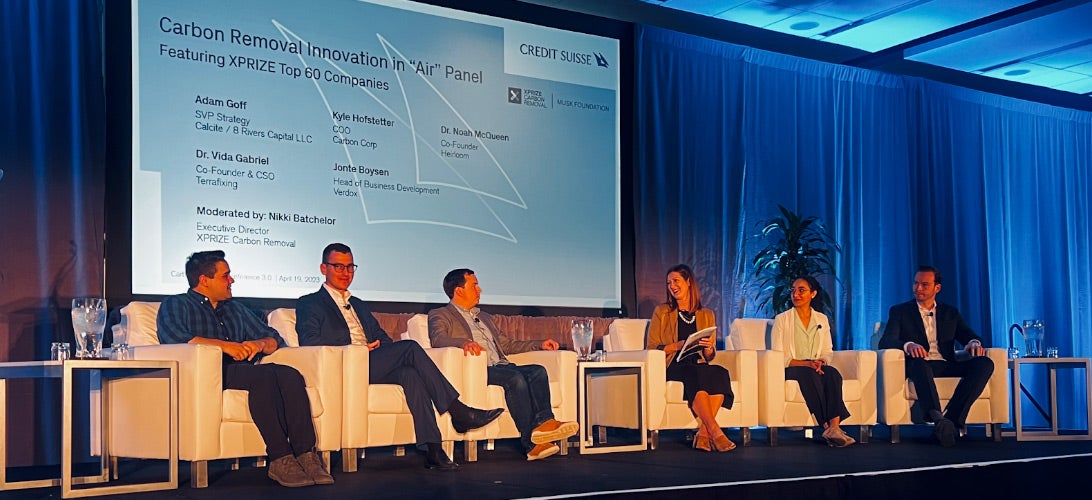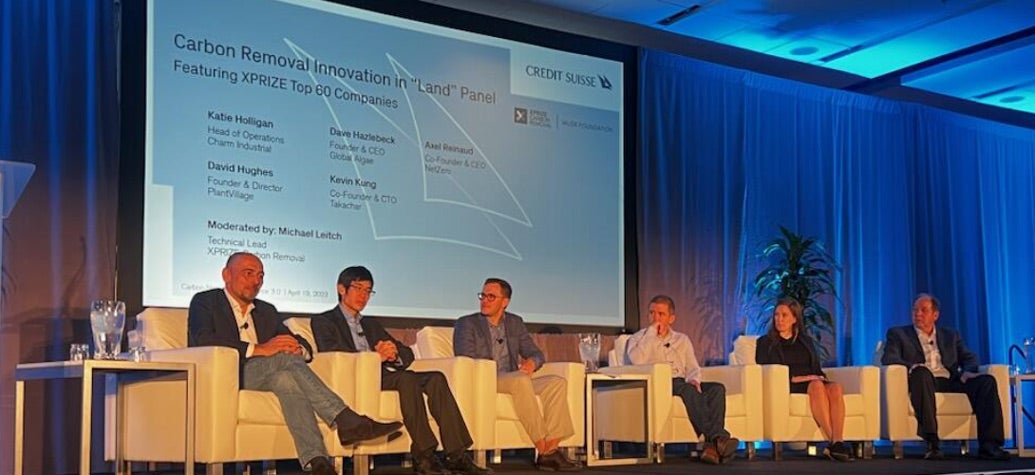This past Earth Day marked the two-year anniversary of XPRIZE Carbon Removal! The team spent it in San Francisco co-hosting the Carbon Negative Conference 3.0.– one of the largest carbon removal convenings to date, bringing together over 600 stakeholders across the industry including investors, corporate buyers, experts, and start-ups, including the XPRIZE Carbon Removal Top 60 Teams from the Milestone Round of the competition. We were inspired to see how far the teams have come in just a short period of time and how much excitement and momentum is building around the carbon dioxide removal (CDR) industry.
To kick off the conference, we organized a series of panels to discuss the latest trends across the various CDR pathways: air, land, oceans, and rocks. The panels all featured XPRIZE Top 60 teams working on a diverse cross-section of solutions. Below is a recording and recap of the discussions around the state of innovation in each pathway, how the industry is evolving, and the biggest challenges and opportunities facing carbon dioxide removal innovators.
Carbon Removal Innovations in “Air” Panel

Panlists from left to right: Dr. Noah McQueen, Co-Founder, Heirloom, Adam Goff, SVP Strategy, Calcite/8 Rivers, Kyle Hofstetter, COO, Carbon Corp, Nikki Batchelor, Executive Director, XPRIZE Carbon Removal (moderator), Vida A. Gabriel (Ph.D), Co-Founder and CSO, TerraFixing, and Jonte Boysen, Head of Business Development, Verd
The opening panel of the conference focused on the challenges and opportunities in the rapidly evolving direct air capture (DAC) space. The group reflected on how the industry has evolved in recent years, with a shared sentiment that ten years ago, people, especially investors, looked at you like you were crazy when you explained you were trying to start a DAC company. But that is not necessarily the case now, as the landscape is evolving rapidly. Jonte Boysen (Verdox) reflected that “in the last few years there have been many catalyzing factors and moments that stand out. A large cohort of new companies…showing what is possible, was a big driver for growth for the rest of the industry…and that has also led to government incentives and other things coming in that make investors realize this is not just something fun from a technology perspective, but actually has potential to be meaningful to the climate and to their portfolios”. Some of the recent government incentives include improvements to the 45Q tax credit under the Inflation Reduction Act as well as the 3.5 Billion in DOE funding for the DAC Hubs program from the Bipartisan Infrastructure Law.
Other important topics of conversation included the challenges and opportunities unique to the DAC space. In addition to DAC being expensive and energy-intensive, access to geologic storage remains an ongoing challenge. However, on the positive side, some of the things that make DAC unique are you can locate it anywhere, and have less competition for resources like land and biomass that might restrict how large the industry can scale over time.
Carbon Removal Innovations in “Land” Panel

Panelists left to right: Axel Reinaud, Co-Founder & CEO, NetZero; Kevin Kung, Co-Founder & CTO, Takachar; Michael Leitch, Sr. Technical Lead, XPRIZE Carbon Removal (moderator); David Hughes, Founder & Director, PlantVillage; Katie Holligan, Head of Operations, Charm Industrial; and Dave Hazlebeck, Founder & CEO, Global Algae.
The second panel of the day highlighted many of the “natural” advantages that land-based CDR solutions bring, including economic co-benefits, the ability to scale quickly, and opportunities to leverage economic models that already exist in agricultural industries.
The low cost and ease of deployment of land-based CDR solutions were highlighted by several speakers. Katie Holligan (Charm Industrial) noted that “land based solutions are competitive because we are leveraging the plant or biomass material as the carbon capture technology… We can be very cost competitive because of the lack of design and development spent on carbon capture tech.” Kevin Kung (Takachar) explained how consuming biomass creates an opportunity to leverage very low cost and simple processing equipment that can be distributed broadly. That said, all five panelists highlighted the ways that their companies are working to continue to push the envelope on their technologies and optimize the performance of their solutions. David Hughes (PlantVilliage) described how they leverage mobile phones in the hands of farmers across the global south to provide the tools they need to turn their farms carbon negative, while Axel Renaud (NetZero) reminded us that “pyrolysis [seems simple but] it is actually quite tricky if you want it to work well... You want to have something that is very simple, but also very sophisticated in the same place”.
All five speakers discussed the value that their land-based CDR solutions aim to create, with each company building their business around a varying blend of “co-benefits”, community benefits, revenue through the direct sale of products, and sale of carbon removal credits.
Carbon Removal Innovations in “Rocks” Panel

Panelists from left to right: Dr. Holly Krutka, XPRIZE Judge and Executive Director, University of Wyoming School of Energy Resources (SER) (moderator); Maurice Bryson, Founder, Silicate; Andrew Pedley, CEO, Carbonaught; Robert Niven, Founder & CEO, CarbonCure; Dr. Kari Helgason, Head of Research & Innovation, Carbfix; and Dr. Greg Dipple, Head of Science & Co-Founder, Arca.
This pathway of carbon removal refers to mineralizing CO2 into rocks which includes adding CO2 to concrete, injecting CO2 underground into bedrock, adding to farmland, working with mine tailings, or crushing up rocks to help accelerate natural CO2 absorption timescales (also known as enhanced weathering). It’s an attractive form of carbon removal because it converts CO2 into a chemically stable form, quicker than in other scenarios, with the potential for long duration, or “permanent” storage. Dr. Greg Dipple (Arca), was the resident geologist on the panel, and shared that “more than 90% of carbon on earth is contained in rocks. It’s contained in rocks because it’s thermodynamically stable and is very scalable.” This is especially important when we start to think about the scale of the problem. “The IPCC is saying we need to store at least 100 gigatonnes of CO2 by mid century, which is huge! It’s like two years worth of Niagara Falls in mass” says Dr. Kari Helgason (Carbfix).
Another important benefit of this category of solutions is that they are easier to measure than some of the other pathways. Rob Niven (CarbonCure) adds that “rocks based technologies arguably provide the highest quality carbon credits because of the permanence and MRV. Also many mineralization CDR companies are creating secondary revenue streams such as concrete and agricultural products.”
Carbon Removal Innovations in “Oceans” Panel

Panelists left to right: Dr. Chris Verlinden, XPRIZE Judge and Chief Technology Officer, Applied Ocean Sciences LLC (moderator); Steve Oldham, CEO, Captura; John Ridley, Managing Director, Ocean Nourishment; Kelly Wachowicz, CFO, Planetary; Dr. Gaurav Sant, Co-Founder & Director, Equatic, Inc.; and Jalen Gildersleeve, Advisor, Marine Permaculture Seaforestation Co.
The final panel of the day discussed ocean-based CDR solutions. The panelists represented approaches spanning “biological” pathways (for example, algae and seaweed) and “technical” pathways (for example, electrochemical seawater separation and alkalinity enhancement). Sea water is a natural CO2 sink that contains a significantly higher volumetric concentration of CO2 than air, and it already covers 70% of the earth, it provides a durable alternative to geological storage, and avoids many of the risks of re-emission that we find on land. John Ridley (Ocean Nourishment) explained “the ocean is a very reliable sink of carbon compared to terrestrial carbon sinks due to wildfires and droughts, etc. We need to employ all the tools and think about the whole carbon cycle.”
The panel discussed how despite Ocean CDR’s massive potential to sequester carbon, it is difficult to measure with certainty. Kelly Wachowicz (Planetary) remarks “The notion of a well developed MRV protocol is so important not only for the technical and financial viability it can bring to the of the solution, but also for the sake of building social acceptance and license for ocean alkaline enhancement and other ocean CDR solutions.as a suitable methodology for climate mitigation.“ In closing, the panelists reminded us of the importance of being responsible stewards of the ocean. As Steve Oldham (Captura) put it, “If we don’t look after the ocean, it becomes the next crisis for humanity after the climate crisis”.